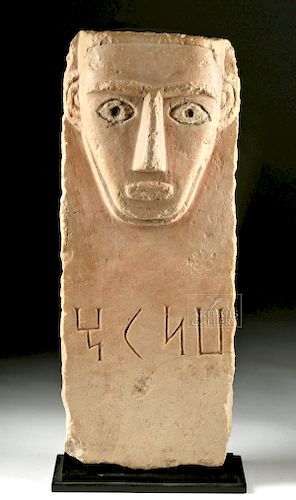Qataban Stone Funerary Stela with Face and Inscription
Lot 126b
About Seller
Artemis Gallery
686 S Taylor Ave, Ste 106
Louisville, CO 80027
United States
Selling antiquities, ancient and ethnographic art online since 1993, Artemis Gallery specializes in Classical Antiquities (Egyptian, Greek, Roman, Near Eastern), Asian, Pre-Columbian, African / Tribal / Oceanographic art. Our extensive inventory includes pottery, stone, metal, wood, glass and textil...Read more
Estimate:
$4,500 - $6,750
Absentee vs Live bid
Two ways to bid:
- Leave a max absentee bid and the platform will bid on your behalf up to your maximum bid during the live auction.
- Bid live during the auction and your bids will be submitted real-time to the auctioneer.
Bid Increments
| Price | Bid Increment |
|---|---|
| $0 | $25 |
| $300 | $50 |
| $1,000 | $100 |
| $2,000 | $250 |
| $5,000 | $500 |
| $10,000 | $1,000 |
| $20,000 | $2,500 |
| $50,000 | $5,000 |
| $100,000 | $10,000 |
| $200,000 | $20,000 |
About Auction
By Artemis Gallery
Jun 20, 2019
Set Reminder
2019-06-20 10:00:00
2019-06-20 10:00:00
America/New_York
Bidsquare
Bidsquare : Ancient / Ethnographic From Around the World
https://www.bidsquare.com/auctions/artemis-gallery/ancient-ethnographic-from-around-the-world-4217
Around the world & back in time - be amazed at the treasures you will find. Antiquities from Egypt, Greece, Italy and the Near East, Asian, Pre-Columbian, African / Tribal / Oceanic, Native American, Spanish Colonial, Russian Icons, Fine Art, much more! All categories, all price ranges.. all legal Artemis Gallery info@artemisgallery.com
Around the world & back in time - be amazed at the treasures you will find. Antiquities from Egypt, Greece, Italy and the Near East, Asian, Pre-Columbian, African / Tribal / Oceanic, Native American, Spanish Colonial, Russian Icons, Fine Art, much more! All categories, all price ranges.. all legal Artemis Gallery info@artemisgallery.com
- Lot Description
Middle East, South Arabia, Qatabanian culture, ca. 3rd century BCE to 1st century CE. A striking pale brown limestone slab, a high-relief stela, with a carved abstract face with a triangular nose, deep set oval eyes, a small mouth, prominent brow ridge and well-groomed eyebrows, and the suggestion of a crown or headdress. The eyes are inlaid with white shell, which is a rare touch - most examples are found with the shell lost. Below the face is a clear inscription in the ancient Yemeni alphabet (also known as Old South Arabian), probably in the language of the Kingdom of Qataban, with four characters that likely represent the name of the deceased. Size: 8" W x 19.75" H (20.3 cm x 50.2 cm); 21" H (53.3 cm) on included custom stand.
The deceased in this part of the world were often represented by anthropomorphic funerary stelae like this one; however, the face is highly stylized and it is doubtful that this is a portrait of a known individual. They have been found in three areas, one of which was the cemetery at Tamna, the capital city of Qataban. The Kingdom of Qataban rose to prominence in the second half of the 1st millennium BCE because it controlled the trade in frankincense and myrrh, incenses required to be burned at altars during religious rituals further north and west. A haunting and quite unique object, certain to spark conversation, and a reminder of the deeper history of the Middle East.
Provenance: private East Coast, USA collection; ex-Alexandre A du M collection, Maryland, USA, acquired in the 1980s
All items legal to buy/sell under U.S. Statute covering cultural patrimony Code 2600, CHAPTER 14, and are guaranteed to be as described or your money back.
A Certificate of Authenticity will accompany all winning bids.
We ship worldwide and handle all shipping in-house for your convenience.
#143854Repaired at center. Repair is well done and nearly invisible.Condition
- Shipping Info
-
All shipping is handled in-house for your convenience. Your invoice from Artemis Gallery will include shipping calculation instructions. If in doubt, please inquire BEFORE bidding for estimated shipping costs for individual items.
-
- Buyer's Premium



 EUR
EUR CAD
CAD AUD
AUD GBP
GBP MXN
MXN HKD
HKD CNY
CNY MYR
MYR SEK
SEK SGD
SGD CHF
CHF THB
THB














